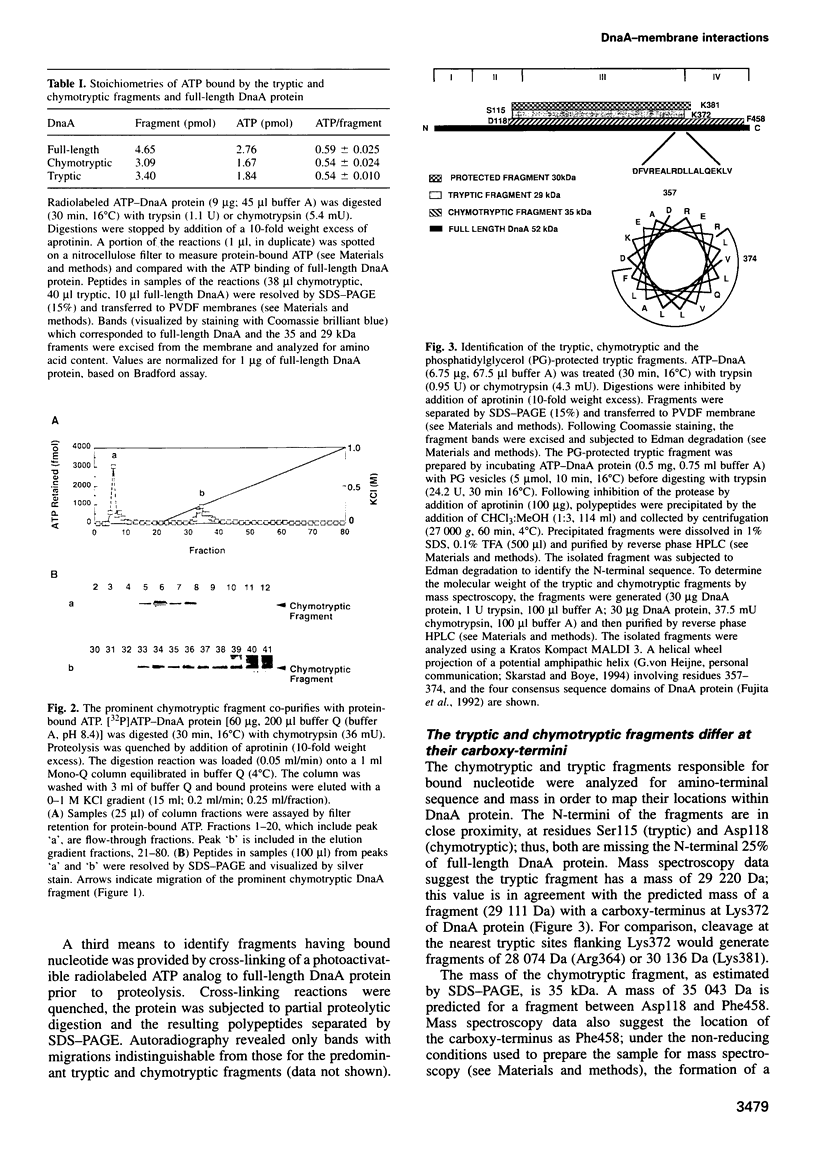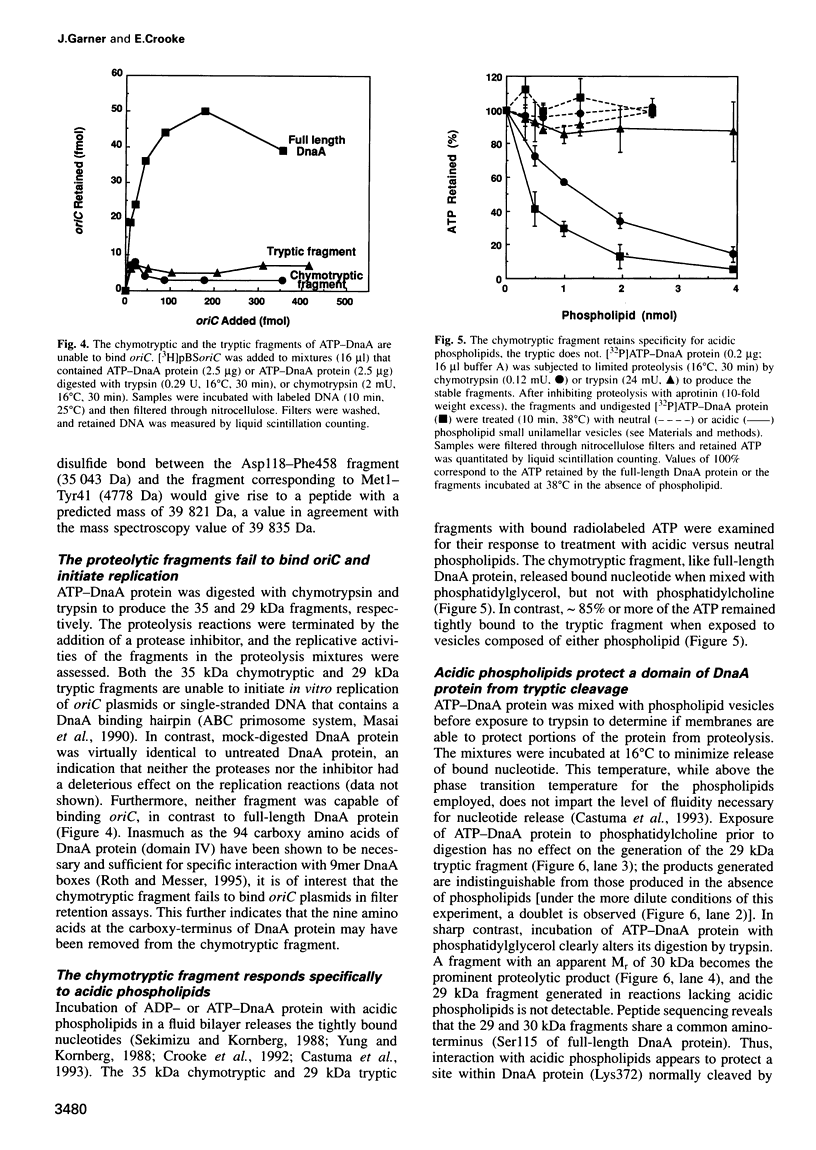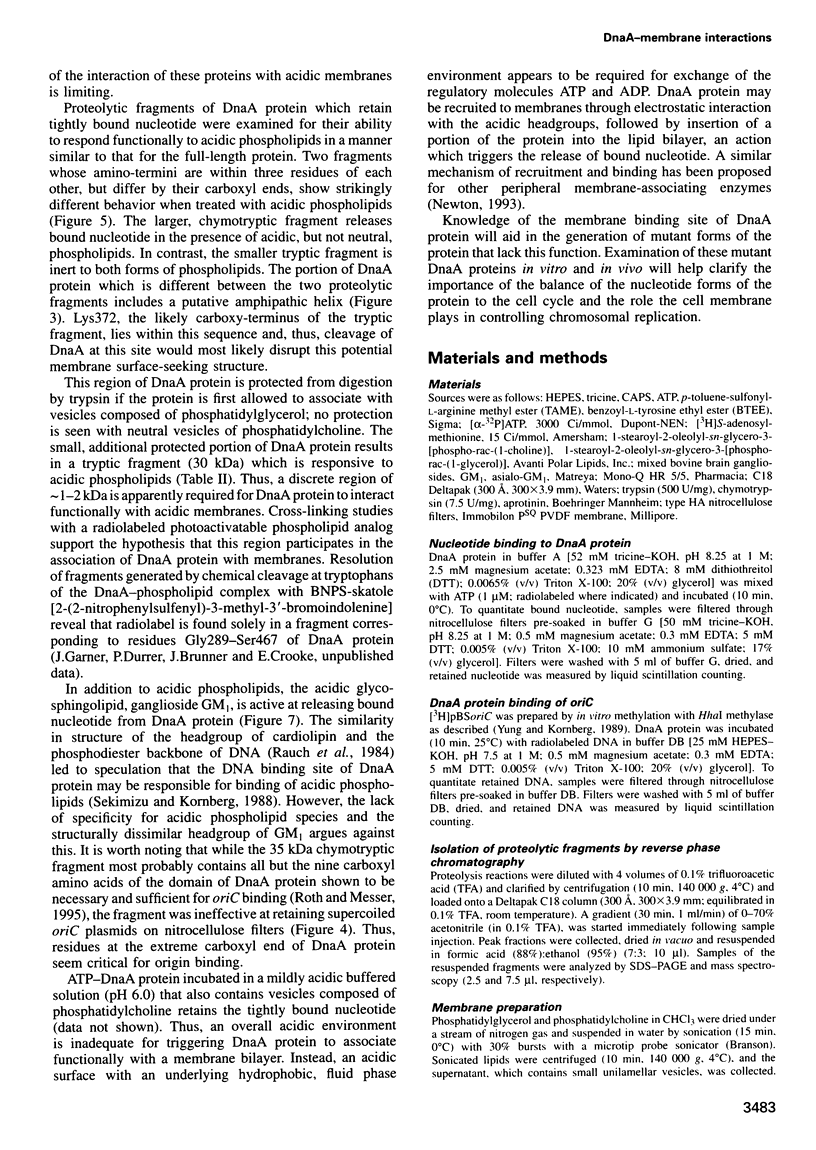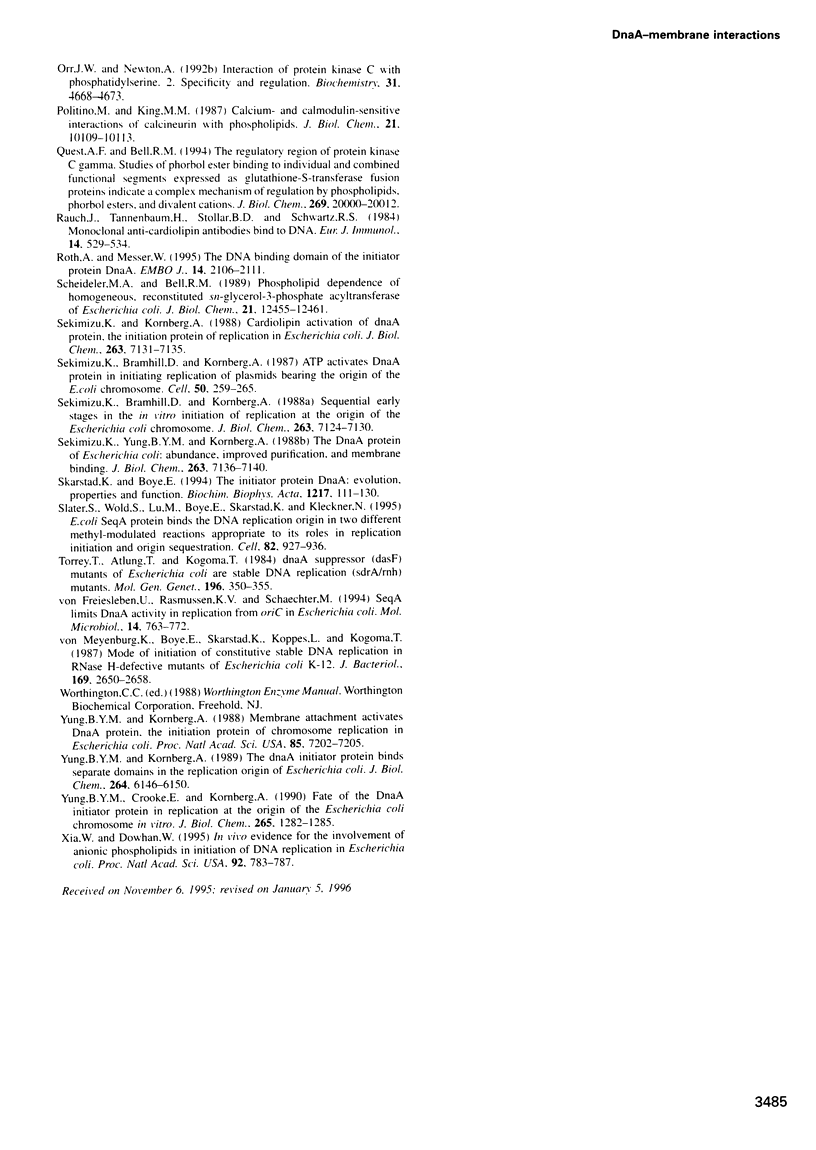Abstract
The capacity of DnaA protein to initiate DNA synthesis at the chromosomal origin is influenced profoundly by the tightly bound nucleotides ATP and ADP. Acidic phospholipids can catalyze the conversion of inactive ADP-DnaA protein into the active ATP form. Proteolytic fragments of the nucleotide form of DnaA protein were examined to determine regions of the protein critical for functional interaction with membranes. A 35 kDa chymotryptic and 29 kDa tryptic fragment retained the tightly bound nucleotide. The fragments, whose amino-termini are within three residues of each other, but differ at their carboxyl ends, showed strikingly different behavior when treated with acidic phospholipids. The larger chymotryptic fragment released the bound nucleotide in the presence of acidic, but not neutral phospholipids. In contrast, the smaller tryptic fragment was inert to both forms of phospholipids. Acidic membranes, but not those composed of neutral phospholipids, protect from tryptic digestion a small portion of the segment that constitutes the difference between the 29 and 35 kDa fragments. The resulting 30 kDa tryptic fragment, which possesses this protected region, interacts functionally with acidic membranes to release the bound effector nucleotide. Inasmuch as the anionic ganglioside GM1, a compound structurally dissimilar to acidic glycerophospholipids, efficiently releases the nucleotide from DnaA protein, an acidic surface associated with a hydrophobic environment is the characteristic of the membrane that appears crucial for regulatory interaction with DnaA protein.
Full text
PDF








Images in this article
Selected References
These references are in PubMed. This may not be the complete list of references from this article.
- AMES B. N., DUBIN D. T. The role of polyamines in the neutralization of bacteriophage deoxyribonucleic acid. J Biol Chem. 1960 Mar;235:769–775. [PubMed] [Google Scholar]
- Bradford M. M. A rapid and sensitive method for the quantitation of microgram quantities of protein utilizing the principle of protein-dye binding. Anal Biochem. 1976 May 7;72:248–254. doi: 10.1016/0003-2697(76)90527-3. [DOI] [PubMed] [Google Scholar]
- Bramhill D., Kornberg A. Duplex opening by dnaA protein at novel sequences in initiation of replication at the origin of the E. coli chromosome. Cell. 1988 Mar 11;52(5):743–755. doi: 10.1016/0092-8674(88)90412-6. [DOI] [PubMed] [Google Scholar]
- Castuma C. E., Crooke E., Kornberg A. Fluid membranes with acidic domains activate DnaA, the initiator protein of replication in Escherichia coli. J Biol Chem. 1993 Nov 25;268(33):24665–24668. [PubMed] [Google Scholar]
- Chakraborti A., Gunji S., Shakibai N., Cubeddu J., Rothfield L. Characterization of the Escherichia coli membrane domain responsible for binding oriC DNA. J Bacteriol. 1992 Nov;174(22):7202–7206. doi: 10.1128/jb.174.22.7202-7206.1992. [DOI] [PMC free article] [PubMed] [Google Scholar]
- Crooke E., Castuma C. E., Kornberg A. The chromosome origin of Escherichia coli stabilizes DnaA protein during rejuvenation by phospholipids. J Biol Chem. 1992 Aug 25;267(24):16779–16782. [PubMed] [Google Scholar]
- Crooke E., Guthrie B., Lecker S., Lill R., Wickner W. ProOmpA is stabilized for membrane translocation by either purified E. coli trigger factor or canine signal recognition particle. Cell. 1988 Sep 23;54(7):1003–1011. doi: 10.1016/0092-8674(88)90115-8. [DOI] [PMC free article] [PubMed] [Google Scholar]
- Crooke E. Regulation of chromosomal replication in E. coli: sequestration and beyond. Cell. 1995 Sep 22;82(6):877–880. doi: 10.1016/0092-8674(95)90020-9. [DOI] [PubMed] [Google Scholar]
- Crooke E., Thresher R., Hwang D. S., Griffith J., Kornberg A. Replicatively active complexes of DnaA protein and the Escherichia coli chromosomal origin observed in the electron microscope. J Mol Biol. 1993 Sep 5;233(1):16–24. doi: 10.1006/jmbi.1993.1481. [DOI] [PubMed] [Google Scholar]
- Fujita M. Q., Yoshikawa H., Ogasawara N. Structure of the dnaA and DnaA-box region in the Mycoplasma capricolum chromosome: conservation and variations in the course of evolution. Gene. 1992 Jan 2;110(1):17–23. doi: 10.1016/0378-1119(92)90439-v. [DOI] [PubMed] [Google Scholar]
- Funnell B. E., Baker T. A., Kornberg A. Complete enzymatic replication of plasmids containing the origin of the Escherichia coli chromosome. J Biol Chem. 1986 Apr 25;261(12):5616–5624. [PubMed] [Google Scholar]
- Hansen F. G., Koefoed S., Atlung T. Cloning and nucleotide sequence determination of twelve mutant dnaA genes of Escherichia coli. Mol Gen Genet. 1992 Jul;234(1):14–21. doi: 10.1007/BF00272340. [DOI] [PubMed] [Google Scholar]
- Heacock P. N., Dowhan W. Alteration of the phospholipid composition of Escherichia coli through genetic manipulation. J Biol Chem. 1989 Sep 5;264(25):14972–14977. [PubMed] [Google Scholar]
- Hendrick J. P., Wickner W. SecA protein needs both acidic phospholipids and SecY/E protein for functional high-affinity binding to the Escherichia coli plasma membrane. J Biol Chem. 1991 Dec 25;266(36):24596–24600. [PubMed] [Google Scholar]
- Hendrickson W. G., Kusano T., Yamaki H., Balakrishnan R., King M., Murchie J., Schaechter M. Binding of the origin of replication of Escherichia coli to the outer membrane. Cell. 1982 Oct;30(3):915–923. doi: 10.1016/0092-8674(82)90296-3. [DOI] [PubMed] [Google Scholar]
- Hwang D. S., Crooke E., Kornberg A. Aggregated dnaA protein is dissociated and activated for DNA replication by phospholipase or dnaK protein. J Biol Chem. 1990 Nov 5;265(31):19244–19248. [PubMed] [Google Scholar]
- Hwang D. S., Kaguni J. M. Interaction of dnaA46 protein with a stimulatory protein in replication from the Escherichia coli chromosomal origin. J Biol Chem. 1988 Aug 5;263(22):10633–10640. [PubMed] [Google Scholar]
- Hwang D. S., Kaguni J. M. Purification and characterization of the dnaA46 gene product. J Biol Chem. 1988 Aug 5;263(22):10625–10632. [PubMed] [Google Scholar]
- Hwang D. S., Kornberg A. Opening of the replication origin of Escherichia coli by DnaA protein with protein HU or IHF. J Biol Chem. 1992 Nov 15;267(32):23083–23086. [PubMed] [Google Scholar]
- Jacq A., Kern R., Tsugita A., Kohiyama M. Purification and characterization of a low-molecular-weight membrane protein with affinity for the Escherichia coli origin of replication. J Bacteriol. 1989 Mar;171(3):1409–1416. doi: 10.1128/jb.171.3.1409-1416.1989. [DOI] [PMC free article] [PubMed] [Google Scholar]
- Katayama T., Crooke E. DnaA protein is sensitive to a soluble factor and is specifically inactivated for initiation of in vitro replication of the Escherichia coli minichromosome. J Biol Chem. 1995 Apr 21;270(16):9265–9271. doi: 10.1074/jbc.270.16.9265. [DOI] [PubMed] [Google Scholar]
- Kusano T., Steinmetz D., Hendrickson W. G., Murchie J., King M., Benson A., Schaechter M. Direct evidence for specific binding of the replicative origin of the Escherichia coli chromosome to the membrane. J Bacteriol. 1984 Apr;158(1):313–316. doi: 10.1128/jb.158.1.313-316.1984. [DOI] [PMC free article] [PubMed] [Google Scholar]
- Landoulsi A., Malki A., Kern R., Kohiyama M., Hughes P. The E. coli cell surface specifically prevents the initiation of DNA replication at oriC on hemimethylated DNA templates. Cell. 1990 Nov 30;63(5):1053–1060. doi: 10.1016/0092-8674(90)90508-c. [DOI] [PubMed] [Google Scholar]
- Lill R., Dowhan W., Wickner W. The ATPase activity of SecA is regulated by acidic phospholipids, SecY, and the leader and mature domains of precursor proteins. Cell. 1990 Jan 26;60(2):271–280. doi: 10.1016/0092-8674(90)90742-w. [DOI] [PubMed] [Google Scholar]
- Marians K. J. Prokaryotic DNA replication. Annu Rev Biochem. 1992;61:673–719. doi: 10.1146/annurev.bi.61.070192.003325. [DOI] [PubMed] [Google Scholar]
- Masai H., Nomura N., Arai K. The ABC-primosome. A novel priming system employing dnaA, dnaB, dnaC, and primase on a hairpin containing a dnaA box sequence. J Biol Chem. 1990 Sep 5;265(25):15134–15144. [PubMed] [Google Scholar]
- Matsudaira P. Sequence from picomole quantities of proteins electroblotted onto polyvinylidene difluoride membranes. J Biol Chem. 1987 Jul 25;262(21):10035–10038. [PubMed] [Google Scholar]
- Moritz A., De Graan P. N., Gispen W. H., Wirtz K. W. Phosphatidic acid is a specific activator of phosphatidylinositol-4-phosphate kinase. J Biol Chem. 1992 Apr 15;267(11):7207–7210. [PubMed] [Google Scholar]
- Newton A. C. Interaction of proteins with lipid headgroups: lessons from protein kinase C. Annu Rev Biophys Biomol Struct. 1993;22:1–25. doi: 10.1146/annurev.bb.22.060193.000245. [DOI] [PubMed] [Google Scholar]
- Newton A. C., Koshland D. E., Jr Phosphatidylserine affects specificity of protein kinase C substrate phosphorylation and autophosphorylation. Biochemistry. 1990 Jul 17;29(28):6656–6661. doi: 10.1021/bi00480a015. [DOI] [PubMed] [Google Scholar]
- Nicolaidis A. A., Holland I. B. Evidence for the specific association of the chromosomal origin with outer membrane fractions isolated from Escherichia coli. J Bacteriol. 1978 Jul;135(1):178–189. doi: 10.1128/jb.135.1.178-189.1978. [DOI] [PMC free article] [PubMed] [Google Scholar]
- Nishizuka Y. Intracellular signaling by hydrolysis of phospholipids and activation of protein kinase C. Science. 1992 Oct 23;258(5082):607–614. doi: 10.1126/science.1411571. [DOI] [PubMed] [Google Scholar]
- Ogawa T., Pickett G. G., Kogoma T., Kornberg A. RNase H confers specificity in the dnaA-dependent initiation of replication at the unique origin of the Escherichia coli chromosome in vivo and in vitro. Proc Natl Acad Sci U S A. 1984 Feb;81(4):1040–1044. doi: 10.1073/pnas.81.4.1040. [DOI] [PMC free article] [PubMed] [Google Scholar]
- Ogden G. B., Pratt M. J., Schaechter M. The replicative origin of the E. coli chromosome binds to cell membranes only when hemimethylated. Cell. 1988 Jul 1;54(1):127–135. doi: 10.1016/0092-8674(88)90186-9. [DOI] [PubMed] [Google Scholar]
- Olivera A., Rosenthal J., Spiegel S. Effect of acidic phospholipids on sphingosine kinase. J Cell Biochem. 1996 Mar 15;60(4):529–537. doi: 10.1002/(sici)1097-4644(19960315)60:4<529::aid-jcb9>3.0.co;2-u. [DOI] [PubMed] [Google Scholar]
- Orr J. W., Newton A. C. Interaction of protein kinase C with phosphatidylserine. 1. Cooperativity in lipid binding. Biochemistry. 1992 May 19;31(19):4661–4667. doi: 10.1021/bi00134a018. [DOI] [PubMed] [Google Scholar]
- Orr J. W., Newton A. C. Interaction of protein kinase C with phosphatidylserine. 2. Specificity and regulation. Biochemistry. 1992 May 19;31(19):4667–4673. doi: 10.1021/bi00134a019. [DOI] [PubMed] [Google Scholar]
- Politino M., King M. M. Calcium- and calmodulin-sensitive interactions of calcineurin with phospholipids. J Biol Chem. 1987 Jul 25;262(21):10109–10113. [PubMed] [Google Scholar]
- Quest A. F., Bell R. M. The regulatory region of protein kinase C gamma. Studies of phorbol ester binding to individual and combined functional segments expressed as glutathione S-transferase fusion proteins indicate a complex mechanism of regulation by phospholipids, phorbol esters, and divalent cations. J Biol Chem. 1994 Aug 5;269(31):20000–20012. [PubMed] [Google Scholar]
- Rauch J., Tannenbaum H., Stollar B. D., Schwartz R. S. Monoclonal anti-cardiolipin antibodies bind to DNA. Eur J Immunol. 1984 Jun;14(6):529–534. doi: 10.1002/eji.1830140609. [DOI] [PubMed] [Google Scholar]
- Roth A., Messer W. The DNA binding domain of the initiator protein DnaA. EMBO J. 1995 May 1;14(9):2106–2111. doi: 10.1002/j.1460-2075.1995.tb07202.x. [DOI] [PMC free article] [PubMed] [Google Scholar]
- Scheideler M. A., Bell R. M. Phospholipid dependence of homogeneous, reconstituted sn-glycerol-3-phosphate acyltransferase of Escherichia coli. J Biol Chem. 1989 Jul 25;264(21):12455–12461. [PubMed] [Google Scholar]
- Sekimizu K., Bramhill D., Kornberg A. ATP activates dnaA protein in initiating replication of plasmids bearing the origin of the E. coli chromosome. Cell. 1987 Jul 17;50(2):259–265. doi: 10.1016/0092-8674(87)90221-2. [DOI] [PubMed] [Google Scholar]
- Sekimizu K., Bramhill D., Kornberg A. Sequential early stages in the in vitro initiation of replication at the origin of the Escherichia coli chromosome. J Biol Chem. 1988 May 25;263(15):7124–7130. [PubMed] [Google Scholar]
- Sekimizu K., Kornberg A. Cardiolipin activation of dnaA protein, the initiation protein of replication in Escherichia coli. J Biol Chem. 1988 May 25;263(15):7131–7135. [PubMed] [Google Scholar]
- Sekimizu K., Yung B. Y., Kornberg A. The dnaA protein of Escherichia coli. Abundance, improved purification, and membrane binding. J Biol Chem. 1988 May 25;263(15):7136–7140. [PubMed] [Google Scholar]
- Skarstad K., Boye E. The initiator protein DnaA: evolution, properties and function. Biochim Biophys Acta. 1994 Mar 1;1217(2):111–130. doi: 10.1016/0167-4781(94)90025-6. [DOI] [PubMed] [Google Scholar]
- Slater S., Wold S., Lu M., Boye E., Skarstad K., Kleckner N. E. coli SeqA protein binds oriC in two different methyl-modulated reactions appropriate to its roles in DNA replication initiation and origin sequestration. Cell. 1995 Sep 22;82(6):927–936. doi: 10.1016/0092-8674(95)90272-4. [DOI] [PubMed] [Google Scholar]
- Torrey T. A., Atlung T., Kogoma T. dnaA suppressor (dasF) mutants of Escherichia coli are stable DNA replication (sdrA/rnh) mutants. Mol Gen Genet. 1984;196(2):350–355. doi: 10.1007/BF00328070. [DOI] [PubMed] [Google Scholar]
- Xia W., Dowhan W. In vivo evidence for the involvement of anionic phospholipids in initiation of DNA replication in Escherichia coli. Proc Natl Acad Sci U S A. 1995 Jan 31;92(3):783–787. doi: 10.1073/pnas.92.3.783. [DOI] [PMC free article] [PubMed] [Google Scholar]
- Yung B. Y., Crooke E., Kornberg A. Fate of the DnaA initiator protein in replication at the origin of the Escherichia coli chromosome in vitro. J Biol Chem. 1990 Jan 25;265(3):1282–1285. [PubMed] [Google Scholar]
- Yung B. Y., Kornberg A. Membrane attachment activates dnaA protein, the initiation protein of chromosome replication in Escherichia coli. Proc Natl Acad Sci U S A. 1988 Oct;85(19):7202–7205. doi: 10.1073/pnas.85.19.7202. [DOI] [PMC free article] [PubMed] [Google Scholar]
- Yung B. Y., Kornberg A. The dnaA initiator protein binds separate domains in the replication origin of Escherichia coli. J Biol Chem. 1989 Apr 15;264(11):6146–6150. [PubMed] [Google Scholar]
- von Freiesleben U., Rasmussen K. V., Schaechter M. SeqA limits DnaA activity in replication from oriC in Escherichia coli. Mol Microbiol. 1994 Nov;14(4):763–772. doi: 10.1111/j.1365-2958.1994.tb01313.x. [DOI] [PubMed] [Google Scholar]
- von Meyenburg K., Boye E., Skarstad K., Koppes L., Kogoma T. Mode of initiation of constitutive stable DNA replication in RNase H-defective mutants of Escherichia coli K-12. J Bacteriol. 1987 Jun;169(6):2650–2658. doi: 10.1128/jb.169.6.2650-2658.1987. [DOI] [PMC free article] [PubMed] [Google Scholar]






